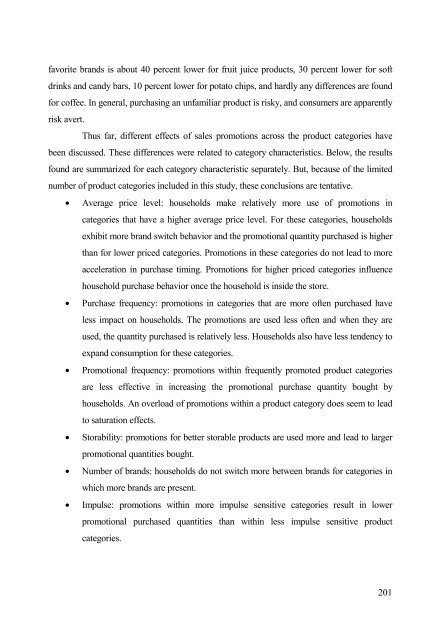Analysis of Sales Promotion Effects on Household Purchase Behavior
Analysis of Sales Promotion Effects on Household Purchase Behavior
Analysis of Sales Promotion Effects on Household Purchase Behavior
Create successful ePaper yourself
Turn your PDF publications into a flip-book with our unique Google optimized e-Paper software.
favorite brands is about 40 percent lower for fruit juice products, 30 percent lower for s<str<strong>on</strong>g>of</str<strong>on</strong>g>t<br />
drinks and candy bars, 10 percent lower for potato chips, and hardly any differences are found<br />
for c<str<strong>on</strong>g>of</str<strong>on</strong>g>fee. In general, purchasing an unfamiliar product is risky, and c<strong>on</strong>sumers are apparently<br />
risk avert.<br />
Thus far, different effects <str<strong>on</strong>g>of</str<strong>on</strong>g> sales promoti<strong>on</strong>s across the product categories have<br />
been discussed. These differences were related to category characteristics. Below, the results<br />
found are summarized for each category characteristic separately. But, because <str<strong>on</strong>g>of</str<strong>on</strong>g> the limited<br />
number <str<strong>on</strong>g>of</str<strong>on</strong>g> product categories included in this study, these c<strong>on</strong>clusi<strong>on</strong>s are tentative.<br />
• Average price level: households make relatively more use <str<strong>on</strong>g>of</str<strong>on</strong>g> promoti<strong>on</strong>s in<br />
categories that have a higher average price level. For these categories, households<br />
exhibit more brand switch behavior and the promoti<strong>on</strong>al quantity purchased is higher<br />
than for lower priced categories. <str<strong>on</strong>g>Promoti<strong>on</strong></str<strong>on</strong>g>s in these categories do not lead to more<br />
accelerati<strong>on</strong> in purchase timing. <str<strong>on</strong>g>Promoti<strong>on</strong></str<strong>on</strong>g>s for higher priced categories influence<br />
household purchase behavior <strong>on</strong>ce the household is inside the store.<br />
• <strong>Purchase</strong> frequency: promoti<strong>on</strong>s in categories that are more <str<strong>on</strong>g>of</str<strong>on</strong>g>ten purchased have<br />
less impact <strong>on</strong> households. The promoti<strong>on</strong>s are used less <str<strong>on</strong>g>of</str<strong>on</strong>g>ten and when they are<br />
used, the quantity purchased is relatively less. <strong>Household</strong>s also have less tendency to<br />
expand c<strong>on</strong>sumpti<strong>on</strong> for these categories.<br />
• <str<strong>on</strong>g>Promoti<strong>on</strong></str<strong>on</strong>g>al frequency: promoti<strong>on</strong>s within frequently promoted product categories<br />
are less effective in increasing the promoti<strong>on</strong>al purchase quantity bought by<br />
households. An overload <str<strong>on</strong>g>of</str<strong>on</strong>g> promoti<strong>on</strong>s within a product category does seem to lead<br />
to saturati<strong>on</strong> effects.<br />
• Storability: promoti<strong>on</strong>s for better storable products are used more and lead to larger<br />
promoti<strong>on</strong>al quantities bought.<br />
• Number <str<strong>on</strong>g>of</str<strong>on</strong>g> brands: households do not switch more between brands for categories in<br />
which more brands are present.<br />
• Impulse: promoti<strong>on</strong>s within more impulse sensitive categories result in lower<br />
promoti<strong>on</strong>al purchased quantities than within less impulse sensitive product<br />
categories.<br />
201

















